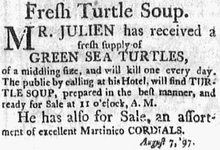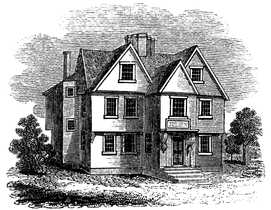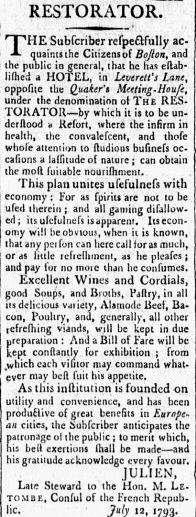Julien's Restorator
Julien's Restorator (c. 1793-1823) was a restaurant in Boston, Massachusetts, established by French-born Jean Baptiste Gilbert Payplat dis Julien.[1] It was one of the first restaurants in Boston; previous public eating-rooms were in "taverns or boarding houses."[2]

History
Julien moved to the United States "as cook to the celebrated Dubuque, who was a refugee from the French Revolution."[2][3][4] Prior to 1793, Julien had served as "steward to the Hon. M. LeTombe, consul of the French Republic."[5] Other friends and associates included Jean Anthelme Brillat-Savarin.[6]

The Restorator opened in July 1793: "a resort where the infirm in health, the convalescent, and those whose attention to studious business occasions a lassitude of nature; can obtain the most suitable nourishment. ... Spirits are not to be used; ... and all gaming is disallowed. ... Excellent wines and cordials, good soups and broths, pastry in all its delicious variety, alamode beef, bacon, poultry, and generally, all other refreshing viands, will be kept in due preparation: and a bill of fare will be kept ... from which each visitor may command whatever may best suit his appetite."[5]
The business first stood on Congress Street "opposite the Quaker's meeting house" in the Financial District, then in 1794 settled on Milk Street (corner of Congress St.)[7] in "the house lately occupied by Mr. Thomas Clements."[8] The building had been erected in 1670-1671 by Henry Bridgham.[9][10] Julien's was "agreeably situated to receive the fresh air -- which is so necessary for the convalescent and strangers."[8] The establishment was referred to as "Julien's," the "Boston Restorator," "Mr. Julien's French Restorator," "Julien's Restorator," or "The Restorator."

According to food historians Julien's "public eating house ... was famous for his soups and stews, and he was nicknamed the 'Prince of Soups.' He is credited with introducing to America the julienne soup, a composition of vegetables in long, narrow strips. Julien specialized in making turtle soup."[1] Julien's advertisements for the soup emphasized medical justifications: "Turtle soup. Much has been said on its efficacy in purifying the blood by Tissot in his celebrated dissertation on the subject, and by Buffon, the great naturalist, who discovered the beneficial nature of amphibious animals. Those who use this soup must not expect that it be made strong with spice, but from ingredients clear and light."[11] "Many celebrated physicians have recommended it. ... As the first establishment of a restorator in Paris was not for Epicurians -- but for the benefit of those invalids who stood in need of light substance, nourishing and strengthening to their stomacks, it was recommended for the purpose by the Academy in Paris. Citizens of the above description are invited to call and try the virtue of Julien's turtle soup."[12] Julien stressed the healthiness of other items available to his patrons, such as "Naples cordials, syrup of vinegar, syrup of orgeat, and white Bourdeaux wine, all of which are calculated for strengthening and invigorating the system of nature during the heat of summer."[12]
The particulars of Julien's style of business and its inspiration to competitors resonated culturally, for example in a literary spoof in the New England Palladium newspaper, 1801:
In imitation of Mr. Julien, I mean to open a house of public entertainment, where every intellectual epicure may be gratified with his favourite dish. The moralist shall be feasted with ethics, the philologist with criticism, and the weak and delicate palates of beaus and ladies shall be indulged with remarks on dress and fashion. After the sumptuous repasts afforded by the Tatler, Spectator, Guardian, Rambler, &c. every succeeding candidate for public favour, in this province, must appear to disadvantage; nor have I the presumption to imagine, that I can produce any thing which can vie, in point of excellence, with the choice dishes of those able caterers. But as the situation and habits of the new world differ considerably from those of the old, if I should be so fortunate as to hit the taste of my customers, I shall have no mean opinion of my cookery. ...[13]
Events that took place at the Restorator included a July 4th dinner of the "officers of the first regiment" in 1798;[14] and anniversary celebrations of the Boston Franklin Typographical Association, 1803-1805.[15][16][17]
Julien died in 1805, and was buried in the Central Burying Ground.[18][19] His wife Hannah Julien continued at the Restorator through at least 1813.[20][21] Around 1816 it was "continued under the management of a countryman of Mr. Julien,"[22] Frederick Rouillard, until 1823.[23][24][25] The building was demolished in 1824, and in 1825 Edward H. Robbins built on the old site of the Restorator a multi-functional assembly space, Julien Hall, named in honor of the now-defunct restaurant.[26]
References

- Andrew F. Smith, ed. The Oxford companion to American food and drink. Oxford University Press US, 2007; p.550
-
- James Henry Stark. Antique views of ye towne of Boston. Boston: Photo-Electrotype Engraving Co., 1882. Google books
- "Dubuque occupied for a time the Shirley mansion in Roxbury." cf. Samuel Adams Drake. Old landmarks and historic personages of Boston. Boston: J. R. Osgood, 1873
- "M. Dubuque, from Martinique." Cf. Winsor. Memorial history of Boston, v.3. 1882
- Restorator. American Apollo (Boston), July 19, 1793
- Larry Stettner, Bill Morrison. Cooking for the Common Good: The Birth of a Natural Foods Soup Kitchen. Berkeley, Calif.: North Atlantic Books, 2010; p.12
- Boston Directory. 1806, 1810
- Boston Restorator. American Apollo (Boston), Aug. 21, 1794
- Robert Blair St. George . Afterthoughts on "Material Life in America, 1600-1860": Household Space in Boston, 1670-1730. Winterthur Portfolio, Vol. 32, No. 1 (Spring, 1997); p.36
- Abbott Lowell Cummings. The Domestic Architecture of Boston, 1660-1725. Archives of American Art Journal, Vol. 9, No. 4 (1971)
- Boston Restorator. Columbian Centinel; Date: 05-04-1796
- Boston Restorator: Turtle Soup. Boston Price-Current; Date: 06-29-1797
- New England Palladium, 1801; reprinted in the Monthly Anthology, July 1804. Google books
- The National Jubilee. Columbian Centinel; Date: 07-07-1798
- Franklin Association. Republican Gazetteer (Boston); Date: 01-26-1803
- Boston Gazette, Jan. 23, 1804
- Boston Gazette, Jan. 17, 1805
- King's hand-book of Boston. 1889; p.240
- John B. Julien (1753-1805). cf. Ogden Codman, comp. Gravestone inscriptions and records of tomb burials in the Central burying ground, Boston Common: and inscriptions in the South burying ground, Boston. The Essex institute, 1917. Google books
- Boston Directory. 1813
- "Fresh oysters. Just received at Mrs. Julien's Hotel, Liberty Square." cf. The Repertory (Boston), Feb. 29, 1816
- Julien's Restorator. Boston Gazette. May 2, 1816
- Boston Directory. 1823
- Boston Daily Advertiser; Date: 04-21-1823
- Drake. 1917
- Caleb Snow. History of Boston, 3rd ed. 1838.
Further reading
- Arthur W. Brayley. "An originator of soups." Boston Cooking School Magazine. v.10, no.9, April 1906. Google books
- Samuel Adams Drake. Old Boston taverns and tavern clubs, illus. ed. Boston: W. A. Butterfield, 1917. Google books
External links
| Wikimedia Commons has media related to Julien's Restorator. |
- Boston Athenaeum. 1796 drawing by Samuel Dearborn of Milk St. and vicinity, depicting Julien's and other buildings